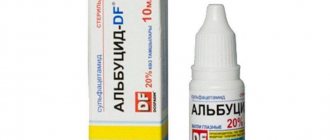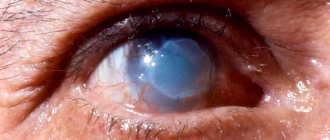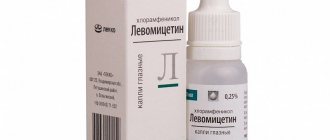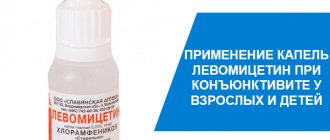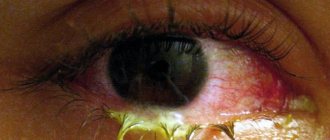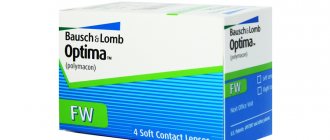Among the reasons why people turn to an ophthalmologist, infectious inflammation of the eyes comes first. Inflammation occurs most often due to bacteria. Therefore, the use of antibacterial drops is effective for treating diseases.
Time-tested drugs with targeted antimicrobial action Albucid and Levomycytin are well-known fighters for eye health. However, being analogues of each other, they have differences in application and the presence of contraindications. This must be taken into account when choosing a medicine.
Albucid
The active ingredient in eye drops is sodium sulfacyl , which has bacteriostatic properties and is an antibiotic. Belongs to the group of sulfonamides. It is prescribed to patients as a prophylactic or therapeutic drug for infectious inflammation.
Sulfanilamide eliminates diseases caused by streptococci, staphylococci, and is used in the treatment of many diseases:
- Keratitis.
- Blepharitis.
- Conjunctivitis.
- Ulcers on the cornea.
- Gonorrheal diseases and other eye infections.
The popularity of the drug is due to the lack of age restrictions . Drops can be prescribed to children of the first year of life, and any other age category. According to the content of the active substance sodium sulfacyl, it can be 20% (for children) or 30% (for adults). The product should be instilled 2-3 drops up to six times a day .
Even if the inflammatory process is one-sided, both eyes must be treated to prevent the spread of infection. Gradually, the number of daily procedures should be reduced. Use drops until the unpleasant symptoms disappear.
Among the possible side effects, patients note a burning sensation, slight redness of the eyelid or cornea, and swelling. The manifestation of symptoms of irritation indicates the need to reduce the frequency of use of the drug. Unpleasant sensations after using eye drops quickly pass.
The medicine has no contraindications, except for individual intolerance.
Comparison of drugs
Composition and action
The drug Albucid consists of an active component - sulfacetamide, which has pronounced antibacterial activity. The substance easily penetrates the tissue structures of the eye and suppresses the proliferation of pathogenic microorganisms, as a result of which they die. "Albucid" is sold in the form of drops used for eye drops. Its absolute analogue, Levomycetin, consists of another main ingredient, namely chloramphenicol. It also has an antibacterial effect, i.e. it stops the growth and reproduction of pathogenic cells by disrupting intracellular protein synthesis.
Return to contents
Prescriptions and contraindications
The drug is prescribed for the treatment of barley, conjunctivitis, blepharitis.
In ophthalmology, Albucid eye drops are actively used for conjunctivitis, purulent ulcerative lesions of the cornea and blepharitis. The medicine is also widely used for the prevention of purulent inflammation of the optic organ in newborns, as well as in patients who have undergone ophthalmic surgery. Albucid is often used to treat barley. "Levomycetin" also effectively treats blepharitis, inflammatory damage to the mucous membrane and eyelids of the eye. Secondary bacterial infections are also susceptible to chloramphenicol-based ophthalmic drops.
Contraindications to Albucid include personal intolerance to any of the components. The medicine has no other restrictions on its use and can be prescribed even to children immediately after their birth. A local antibiotic is not contraindicated during pregnancy.
Levomycetin has a much longer list of contraindications and includes such pathologies as:
- hypersensitivity to the components of the drug;
- impaired activity of the kidneys and liver in a chronic form;
- skin pathologies;
- G6PD deficiency.
Drops are contraindicated for young children and women during lactation.
"Levomycetin" is not recommended for children under 2 years of age, but at the discretion of the ophthalmologist it can be prescribed before this age. In case of emergency, the eye drops in question are prescribed to women carrying a child and nursing mothers. Consequently, during the period of treatment of eye pathologies with Levomycetin, it will be necessary to stop breastfeeding.
Return to contents
Directions for use and doses
The correct use of eye drops is described in detail in the instructions, but in what dosage to use the medicine, it is better to discuss with a specialized physician - an ophthalmologist. Thus, the annotation for the drug “Albucid” presents general recommendations and according to them, it is recommended to apply eye drops during exacerbation of inflammatory processes up to 6 times a day, 2-3 drops. Use until the symptoms associated with the disease disappear. However, as the manifestations of the disease decrease, it is necessary to reduce the number of instillations per day daily. Typically, final recovery occurs within 7 days from the start of therapy. A child should use Albucid 20% for eye drops.
"Levomycetin" is instilled into each eye, 1-2 drops with an interval of 4 hours. An ophthalmologist will tell you more specifically about the dosage regimen and duration of treatment, who will select treatment individually for each patient, depending on the causative agent and the severity of the disease. For children over 3 years old, Levomycetin is prescribed 1 drop in the eye up to 4 times a day.
Return to contents
Negative effects
During therapy, eye hyperemia may occur.
Albucid is usually well tolerated and causes side symptoms extremely rarely. But even if any undesirable effects occur, this is not a reason to immediately refuse the medicine; perhaps the doctor will prescribe a solution of a lower concentration. The following symptoms may appear against the background of Albucid instillations:
- swelling, redness of the conjunctiva;
- itching of the skin of the eyelids;
- copious secretion of tear fluid;
- burning, irritation.
People with hypersensitivity to thiazide drugs, as well as those who exceed the doses recommended by the ophthalmologist, often develop a negative reaction.
The use of Levomycetin can cause such undesirable effects as:
The product may cause severe lacrimation and pain.
- rash around the skin of the visual organ;
- increased lacrimation;
- burning pain, itching;
- secondary fungal infection.
Return to contents
Is there a difference in price?
When choosing a medicine for eye diseases, cost is of no small importance. Thus, the ophthalmic drug “Albucid” can be purchased at a Russian pharmacy for 80-95 rubles. The eye medicine “Levomycetin” costs no more than 15 rubles, and in some regions you can buy it for up to 10 rubles. At the same time, a low price does not mean that the medical product is ineffective; the difference in cost is due to different manufacturing companies.
Return to contents
Levomycytin
Having a wide spectrum of action, Levomycytin is a representative of the chloramphenicol group and contains the active substance of the same name. It is an antibiotic and is used to fight many bacteria. Prescribed in the form of eye drops for the treatment of inflammatory processes.
Eye diseases for which Levomycytin is prescribed:
- Conjunctivitis.
- Endophthalmitis.
- Meibomite.
- Iridocyclitis.
- Dacryocystitis.
- Blepharitis.
Drops of the solution can be used starting from the age of two. The frequency of use and duration of therapy are individually selected by the ophthalmologist. Depends on the age of the patient, the symptoms of inflammation, and the complexity of the disease.
Drops should not be used for dermatological diseases of the skin around the eyes, for pregnant women, or during breastfeeding. A contraindication may be individual intolerance to the active substance.
Levomycytin can cause skin rash, irritation, and increased lacrimation. Of the adverse reactions, allergic manifestations are most often observed. Itching, burning, redness of the eyes, and in some cases painful sensations appear.
General properties of drugs
It is difficult to answer unequivocally which is better, “Levomycetin” or “Albucid”. Both of these drugs are characterized by a bactericidal effect. Their use is acceptable for both adults and children. The level of safety when using eye drops is high, since the active component is not able to penetrate into the blood in high concentrations and affect the functionality of vital organs.
Which is better - Albucid or Levomycetin eye drops - for conjunctivitis or another disease, it is also impossible to say categorically. Both drugs are effective, despite the fact that they belong to different drug groups. They inhibit the development and reproduction of pathogens, and also stop the inflammatory process, but in different ways.
Side effects may occur with both medications. Both medications can cause burning and itching, which is accompanied by profuse lacrimation, redness of the conjunctiva and a gritty sensation. If unpleasant symptoms appear, the eyes should be rinsed and therapy should be stopped. The possibility of further treatment should be discussed with your doctor.
What do Albucid and Levomycitin have in common?
- Both medications have a bacteriostatic effect, so they are equally effective in treating many eye diseases.
- Can be used for children and adults.
- The amount of active substance absorbed into the bloodstream is insignificant.
- Similar manifestations of side effects.
For one disease, for example, conjunctivitis, both drugs can act equally effectively, although they are representatives of different groups and differ in physicochemical properties. In simple words, they stop the infection in different ways.
Differences in eye drops
It is quite difficult to compare drugs based on the active substance, since they belong to different groups and differ in their directions of action. There are several main distinctive properties of drugs.
- Levomycytin has a more pronounced antibacterial property . It disrupts protein synthesis in microbial cells, leading to their death. Sodium sulfacyl does not have the ability to kill pathogenic microorganisms, but prevents the proliferation of bacteria, creating conditions unfavorable for them.
- Levomycytin affects a wider range of pathogens of inflammatory diseases. However, Albucid is more effective in the fight against streptococci, staphylococci, and gonococci.
- Levomycytin is less absorbed by the circulatory system and has lower toxicity rates (although both drugs have minimal toxicity).
- There are fewer contraindications for the use of Albucid. The only reason for cancellation may be individual intolerance. Sulfacyl sodium is used to treat children from birth, pregnant women, and during breastfeeding.
- With prolonged use of Levomycitin, a side effect is possible - the development of anemia (aplastic anemia).
What to choose - Levomycytin or Albucid?
The harmlessness of Albucid does not mean that it is less effective. A number of diseases caused by the proliferation of microorganisms (conjunctivitis, blepharitis, etc.), both drugs treat equally effectively. Therefore, if there are no contraindications due to age, allergies, pregnancy, or breastfeeding, then any of these two eye solutions can be prescribed. The presence of contraindications for one of the medications is the reason for choosing the second medication. However, there are a number of infections that cannot be treated with Albucid. In this case, the chloramphenicol solution cannot be replaced with sodium sulfacyl.
Doctors can easily identify the causative agent of the disease and prescribe the most useful drug. Seeking advice from an ophthalmologist earlier will help you quickly cope with inflammation and maintain eye health for many years.
Medicine and healthComment
Reviews
According to expert reviews, both drugs are effective against inflammation and infectious eye damage. But it is necessary to use eye drops correctly, taking into account the causative agent of the disease and existing contraindications.
When an inflammatory process develops in the eye, only a doctor can determine which drug is suitable in this case. A timely visit to an ophthalmologist for advice will help maintain the health of your visual organs for many years.
The pharmaceutical preparations “Albucid” and “Levomycetin”, used for the treatment of eye pathologies, often fall under comparison, since both are highly effective and have a similar effect. But which medication is better, the instructions, which give a detailed description of this or that medication, will help you figure it out. The final word when choosing between “Levomycetin” and “Albucid” should remain with a specialized doctor - an ophthalmologist.
IT IS IMPORTANT TO KNOW! Even “neglected” vision can be cured at home, without surgery or hospitals. Just read what Yuri Astakhov says and read the recommendation.

